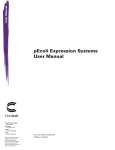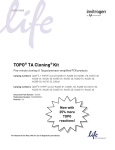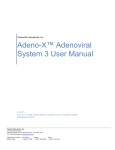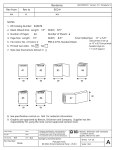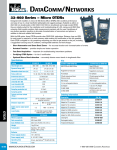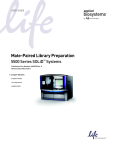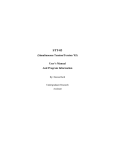Download Mutagenesis with In-Fusion® HD Cloning Plus
Transcript
C l o n i n g a n d C o m p e t e n t C e l l s Mutagenesis with In-Fusion® HD Cloning Plus Timeline Before you begin Pick your vector (any vector!) and envision your final construct. Design and order primers. Day One Linearize your vector by inverse PCR, using your new primers. Perform the In-Fusion reaction with the inverse PCR product. Transform the In-Fusion reaction into Stellar competent cells. Day Two Recover your final construct Note: Although all the examples shown here involve protein coding (gene) sequences, you can use the same methods to modify noncoding sequences such as promoters or transcription factors. • A single system for deletions, base substitutions, or additions • Flexible enough to use with any vector • Over 95% efficiency, guaranteed In-Fusion PCR cloning makes it easy to perform mutagenesis: it combines the power of the In-Fusion HD enzyme with inverse PCR, a method for rapid in vitro amplification of the DNA sequences that flank a region of known sequence (1). During inverse PCR, primers are oriented in opposite directions on your circular cloning vector (Figure 1). To perform mutagenesis with In-Fusion systems, design your PCR primers so that they have a 15 bp overlap with each other at their 5' ends and incorporate the mutation of interest. Use the CloneAmp™ HiFi PCR Premix (a high fidelity PCR polymerase included with all In-Fusion HD Cloning Plus Systems) to perform your PCR reaction, add the In-Fusion HD enzyme premix to your linearized PCR product, and transform into the provided Stellar™ competent cells. You have a ≥95% chance of recovering your final desired construct—the first time and every time. Experimental Overview: 1. Think about your final construct: Choose the vector you want to modify and envision your final, mutated construct (Figure 1; mutation shown in yellow). 2. Design your primers: Design inverse primers that overlap each other by 15 bp at their 5' ends and incorporate your desired deletion, substitution, or addition. Specific guidelines for mutagenesis primer design are described below. 3. Utilize the power of In-Fusion: Using an inverse PCR protocol, amplify the vector with your new primers. Perform the In-Fusion reaction using the PCR product. The linear DNA will re-circularize at the site of the 15 bp overlap and will also contain your mutagenic changes. Transform a portion of the In-Fusion reaction into Stellar Competent Cells according to the In-Fusion HD Cloning Plus protocol. 4. Obtain your final construct: Recover your mutant from the Stellar cells the following day. Change occurs here Visit our website 15 bp overlap 1. Envision final construct 2. Design primers 3. Perform In-Fusion protocol • • • Amplify linear construct Perform In-Fusion reaction to re-circulize vector at 15 bp overlap Transform into Stellar Competent Cells 4. Recover final construct Figure 1. Procedure for performing mutagenesis with In-Fusion systems. The area where mutagenesis occurs is shown in yellow. Clontech Laboratories, Inc. A Takara Bio Company United States/Canada: +1.800.662.2566 • Asia Pacific: +1.650.919.7300 • Europe: +33.(0)1.3904.6880 • Japan: +81.(0)77.543.724 For Research Use Only. Not for use in diagnostic or therapeutic procedures. Not for resale. Clontech, the Clontech logo, CloneAmp, EcoDry, In-Fusion, and Stellar are trademarks of Clontech Laboratories, Inc. All other marks are the property of their respective owners. Certain trademarks may not be r egistered in all jurisdictions. ©2013 Clontech Laboratories, Inc. 6.13 IN (633337) www.clontech.com C l o n i n g a n d C o m p e t e n t C e l l s Primer Design for Deletion Mutagenesis Primer design is a key component of simple, In-Fusion based deletion mutagenesis. To delete a region of your cloning vector, you must design primers that include 15 bp overlap with each other at their 5' ends and do not include the bases to be deleted (Figure 2). For visual interest and easy understanding of the primer design concept, different regions of the vector backbone and primers are marked in color. In Figure 2, the deletion site is marked in yellow and the binding site for the reverse primer (pink and turquoise) spans the deletion. The binding site for the forward primer (turquoise and black) is located against the cloning vector backbone. The two primers overlap by 15 bp at their 5' ends (the common area of turquoise). Note that there is no gap between the pink and turquoise regions in the actual primer sequence—the deleted nucleotides are not included in either of the primers. Deletion site Reverse primer Forward primer 15 bp overlap 1. Envision final construct 2. Design primers, then perform In-Fusion protocol 3. Recover final construct Figure 2. In-Fusion primer design for deletion mutagenesis. Primers are designed to eliminate a section of the original vector. To create a series of C-terminal deletions, design only one forward primer that anneals to your cloning vector immediately downstream of the coding region, retaining the stop codon. Then design a series of reverse primers that include 15 bp of overlap with the forward primer at their 5' ends and span different regions to be deleted. In Figure 3, Construct A has the blue region deleted, Construct B has the blue and turquoise regions deleted, and Construct C has the blue, turquoise and pink regions deleted. Deletion site Original vector Construct A Deletion sites Deletion sites Construct B E Construct C Reverse primers A B C Forward primer A B C 15 bp overlap 1. Envision final constructs 2. Design primers, then perform In-Fusion protocol 3. Recover final constructs Figure 3. In-Fusion primer design to create a series of C-terminal truncated proteins. Primers are designed to eliminate one or more contiguous sections of the original vector. 2 C l o n i n g a n d C o m p e t e n t C e l l s To create a series of N-terminal deletions, design one reverse primer that anneals to your cloning vector immediately upstream of the coding region, retaining the stop codon. Then design a series of forward primers that retain the natural start codon, include 15 bp of overlap with the reverse primer at their 5' ends, anneal to the coding region you wish to maintain at their 3' ends, and span different deletions. In Figure 4, Construct D has the turquoise region deleted and Construct E has the turquoise and blue regions deleted. Deletion sites Deletion site Reverse primer Original vector Construct D Forward primers D E D Construct E E 15 bp overlap 1. Envision final constructs 2. Design primers, then perform In-Fusion protocol 3. Recover final constructs Figure 4. In-Fusion primer design to create a series of N-terminal truncated proteins. Primers are designed to eliminate one or more contiguous sections of the original vector. Primer Design for Base Insertions or Base Substitutions Inserting bases is simple with the In-Fusion systems. To insert bases, design primers that include 15 bp overlaps with each other at their 5' ends and contain the desired insertion(s) within the overlapping region (Figure 5). Only the 15 bases at the 5' ends of the primers are required to overlap, but depending on the length and sequence of your insertion, the overlap may be longer than 15 bp. Additional bases added to the primer will be maintained after the In-Fusion reaction. Similarly, if you would like to change one or more bases in a construct, design primers that include 15 bp overlaps with each other and contain the desired substitutions within the overlapping region (Figure 5). Added or substituted bases go here Reverse primer X XX XXX XXX XXX XXX XXX 3. Amplify linear construct 4. Recover final construct Forward primer Changed bases are within 15 bp overlap 1. Envision final construct 2. Design primers Figure 5. In-Fusion primer design for inserting or substituting bases. Primers are designed to add additional bases or to replace existing bases with different bases (Xs in the in the primers and the final vector) in the original vector. 3 C l o n i n g a n d C o m p e t e n t C e l l s In-Fusion Mutagenesis Protocol Overview Please see the In-Fusion HD Cloning Kit User Manual for detailed instructions. 1. Select your vector and identify the mutation site. 2. Design PCR primers as described above, keeping in mind these general guidelines: • Primers should be 18–25 bases long. Insertions may require longer primers. • Primers should be 40–60% GC • Primer Tms should be 58–65°C. Difference between forward and reverse primer Tms should be ≤ 4°C. 3. Prepare CloneAmp HiFi PCR Master Mix: CloneAmp HiFi PCR Premix..... Forward primer................... Reverse primer.................... Template........................... H2O.................................. 12.5 µl 200–300 nM 200–300 nM 0.1–5.0 ng As needed Total volume/rxn.................. 25 µl 4. Linearize the vector by inverse PCR using a threestep PCR protocol and CloneAmp HiFi PCR Premix. 30–35 cycles: 98°C........ 10 sec 55°C........ 5 or 15 sec 72°C........ 5 sec/kb 5. Treat the PCR product with Cloning Enhancer to remove the circular double-stranded template from the reaction. (Refer to Part VII, Protocol II.A in the In-Fusion HD Cloning Kit User Manual.) If your PCR product contains multiple bands, gelpurify instead using the NucleoSpin Gel and PCR Clean-Up Kit. (Refer to Part VI, Protocol I.A in the In-Fusion HD Cloning Kit User Manual.) 6. Assemble the In-Fusion reaction: Linear construct containing..... 100 ng your mutation In-Fusion enzyme................. 2 μl H2O.................................. As needed Total volume....................... 10 μl 7. Incubate the reaction at 50°C for 15 min. 8. Transform Stellar Competent Cells with 2.5 μl of the In-Fusion reaction. 9. The next day, screen for mutants. You have a ≥95% chance of recovering your final desired construct the very first time. Reference 1. Ochman H., Gerber A. S., Hartl D. L. (1988) Genetics 120(3):621–623. Cat. # Product Package Size 638916 638917 638919 638918 In-Fusion HD Cloning Plus CE Liquid system; includes the In-Fusion Enzyme, CloneAmp HiFi PCR Premix, Stellar Competent Cells, and Cloning Enhancer 10 Rxns 50 Rxns 96 Rxns 100 Rxns 638912 638913 638914 638915 In-Fusion HD EcoDry™ Cloning Plus Lyophilized system; includes the In-Fusion Enzyme, CloneAmp HiFi PCR Premix, Stellar Competent Cells, and Cloning Enhancer 8 Rxns 24 Rxns 48 Rxns 96 Rxns 638909 638910 638920 638911 In-Fusion HD Cloning Plus Liquid system; includes the In-Fusion Enzyme, CloneAmp HiFi PCR Premix, Stellar Competent Cells, and NucleoSpin Gel and PCR Cleanup Kit 10 Rxns 50 Rxns 96 Rxns 100 Rxns Notice to Purchaser Your use of these products and technologies is subject to compliance with any applicable licensing requirements described on the product’s web page at http://www.clontech.com. It is your responsibility to review, understand and adhere to any restrictions imposed by such statements. Clontech® products are to be used for research purposes only. They may not be used for any other purpose, including, but not limited to, use in drugs, in vitro diagnostic purposes, therapeutics, or in humans. Clontech products may not be transferred to third parties, resold, modified for resale, or used to manufacture commercial products or to provide a service to third parties without prior written approval of Clontech Laboratories, Inc. 4




